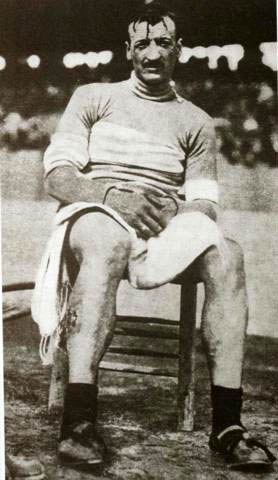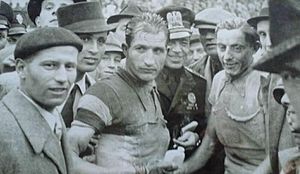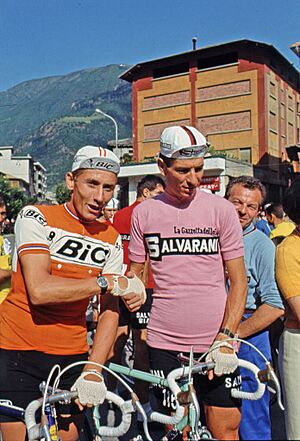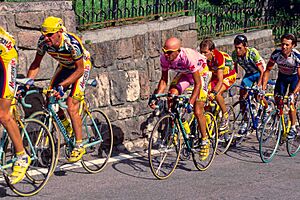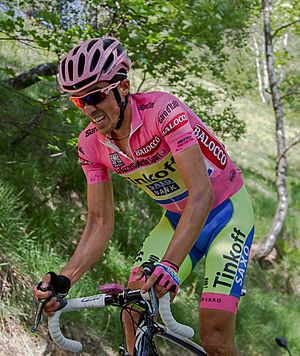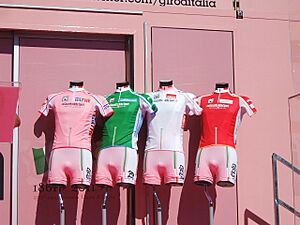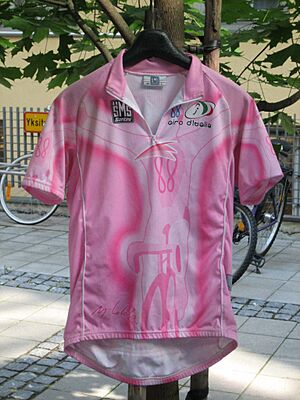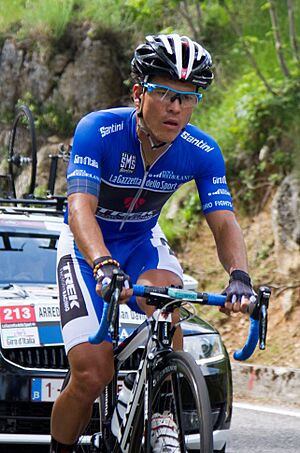Giro d'Italia facts for kids
 |
|
| Race details | |
|---|---|
| Date | May–June |
| Region | Italy and nearby countries |
| English name | Tour of Italy |
| Local name(s) | Giro d'Italia |
| Nickname(s) | La Corsa Rosa (The Pink Race) |
| Discipline | Road |
| Competition | UCI World Tour |
| Type | Grand Tour |
| Organiser | RCS Sport |
| Race director | Mauro Vegni |
| History | |
| First edition | 13 May 1909 |
| Editions | 108 (as of 2025) |
| First winner | |
| Most wins |
|
| Most recent | |
The Giro d'Italia (meaning "Tour of Italy") is a famous yearly bicycle race. It mostly takes place in Italy, but sometimes starts or passes through other countries. People often just call it the Giro.
The first race happened in 1909. It was started by a newspaper called La Gazzetta dello Sport to help sell more copies. The race is still run by a company connected to that newspaper. The Giro has happened every year since 1909, except during the two World Wars.
Over time, the Giro became very popular. It grew longer, and riders from all over the world started to join. The Giro is now a big event in the UCI World Tour. This means that many of the best cycling teams compete in it.
The Giro is one of professional cycling's three "Grand Tours," which are long, three-week races. After the Tour de France, it's the second most important stage race in the world. The Giro usually happens in May, sometimes going into early June. The route changes each year, but it always includes at least two time trials. It also features challenging climbs through the Alps and Dolomites mountains. Modern Giros usually have 21 stages over 23 or 24 days, with a few rest days.
The rider who finishes the race in the shortest total time is the leader. They get to wear the special pink jersey. While winning the overall race is the main goal, winning individual stages is also a big deal. There are other competitions within the Giro too. These include the points classification, the mountains classification for climbers, the young rider classification for riders under 25, and the team classification.
Contents
History of the Giro
How the Giro Started (1909)
The idea for a bike race around Italy came from the success of the Tour de France. The editor of La Gazzetta dello Sport newspaper, Tullo Morgagni, thought Italy needed its own big race. Another newspaper was planning a race, so La Gazzetta wanted to be first.
Even though they didn't have much money, they got donations from many people and even a casino. The first Giro d'Italia was announced on August 7, 1908. It was set for May 1909.
On May 13, 1909, 127 riders started the first Giro in Milan. The race had eight stages and covered about 2,448 kilometers. Only 49 riders finished. Italian rider Luigi Ganna won the first Giro. He won three stages and the overall race.
Early Years (1910–1952)
The race continued with similar rules for a few years. In 1912, only teams were ranked, not individual riders. This was the only time that happened. From 1914 onwards, the winner was decided by who had the lowest total time, which is how it works today.
The Giro was stopped for four years (1915-1918) because of the First World War. Costante Girardengo won the first Giro after the war in 1919.
The 1920s were dominated by Alfredo Binda. He won his first Giro in 1925. In 1927, he won an amazing 12 out of 15 stages! Binda won the Giro five times in total.
Later, Gino Bartali became a top rider. He won two Giros in the 1930s. In 1940, the last Giro before the Second World War, Bartali was beaten by his younger teammate, 20-year-old Fausto Coppi.
Bartali and Coppi became huge rivals, and their competition was very exciting for fans. After the war, Coppi won his second Giro in 1947. Coppi went on to win three more Giros. In 1949 and 1952, he achieved a rare feat: winning both the Giro d'Italia and the Tour de France in the same year.
Mid-Century Champions (1953–1967)
In 1950, Hugo Koblet from Switzerland became the first non-Italian to win the race. The 1950s and 1960s saw many different winners.
Jacques Anquetil from France won the Giro in 1960 and 1964. He was the first rider to win all three Grand Tours (Giro, Tour de France, and Vuelta a España). Felice Gimondi won the 1967 Giro d'Italia and also went on to win all three Grand Tours.
Modern Era (1968–Present)
Belgian rider Eddy Merckx was a dominant force in the 1970s. He won his first Giro in 1968. He won the race five times in total, matching Binda and Coppi's record.
In 1980, Bernard Hinault became the first French winner since Anquetil. He won two more Giros in 1982 and 1985.
The 1987 race was exciting because of a rivalry between teammates Roberto Visentini and Stephen Roche. Roche eventually won the race. He also won the Tour de France and the World Championships that year, completing the "Triple Crown of Cycling."
In 1988, Andrew Hampsten became the first non-European to win the Giro. He won in very bad weather conditions, especially on the tough Passo di Gavia climb.
Miguel Indurain, a Spanish rider who won five Tours de France, won the Giro in 1991 and 1992.
Marco Pantani won the Giro in 1998. He was known for his amazing climbing skills. That same year, he also won the Tour de France, which is a very rare achievement.
In 1999, Pantani was leading the Giro but had to leave the race due to health rules. Ivan Gotti then won the race for the second time.
Other notable winners in the 2000s and 2010s include Gilberto Simoni, Paolo Savoldelli, Ivan Basso, Alberto Contador, and Vincenzo Nibali.
In 2014, Nairo Quintana from Colombia became the first South American to win the Giro.
The 2017 Giro d'Italia was the 100th edition. Tom Dumoulin became the first Dutch rider to win the Giro. He had to overcome stomach problems during a mountain stage but fought back in the final time trial to win.
In 2018, Chris Froome made an incredible solo attack on a mountain stage. He rode 80 kilometers alone to win the race and became the first British rider to win the Giro. He also held all three Grand Tour titles at the same time, a very rare achievement.
Richard Carapaz from Ecuador won in 2019, becoming the first from his country to win. The 2020 race was held in October due to the COVID-19 pandemic. Tao Geoghegan Hart became the second British winner. In 2021, Egan Bernal became the second Colombian winner, and in 2022, Jai Hindley became the first Australian winner.

Primož Roglič from Slovenia won the 2023 Giro d'Italia. He took the lead on the second-to-last stage, a mountain time trial.
In 2024, Tadej Pogačar from Slovenia won the race on his first try. He wore the pink jersey for almost the entire race and won by a huge margin. He also won the mountains classification and six stages. Pogačar then went on to win the 2024 Tour de France, becoming the first rider since Marco Pantani in 1998 to win both the Giro and Tour in the same year.
The 2025 Giro d'Italia saw Simon Yates take the lead on the second-to-last stage.
Race Classifications
While many riders aim to win the overall race, there are other exciting competitions. These include points, mountains, and a classification for young riders. The leader of each main competition wears a special colored jersey. If a rider leads more than one, they wear the jersey for the most important classification (the pink jersey).
General Classification
The most important award in the Giro d'Italia is the general classification. All stages are timed. The rider with the lowest total time after all stages is the race leader. This leader gets to wear the famous pink jersey (Maglia rosa). The jersey is given to the leader on a podium after each stage.
The pink color was chosen because La Gazzetta dello Sport, the newspaper that started the Giro, is printed on pink paper. The pink jersey was first used in 1931. It has become a symbol of the Giro. Riders try to keep the jersey for as long as possible to get attention for their team. Eddy Merckx wore the pink jersey for 78 stages, more than any other rider. Three riders have won the overall race five times: Alfredo Binda, Fausto Coppi, and Eddy Merckx.
In the very first Giro in 1909, the winner was decided by a points system, not by time. Riders got points based on their finishing position in each stage. The rider with the fewest points won. This changed in 1914 to the time-based system used today.
Riders can also get time bonuses for finishing first, second, or third in a stage. These bonuses reduce their total time.
Mountains Classification
The mountains classification is for the best climbers. It was added in 1933 and first won by Alfredo Binda. During mountain stages, points are given to the first riders to reach the top of important climbs. The harder the climb, the more points are awarded.
The leader of the mountains classification wears a blue jersey. If a rider leads both the overall race and the mountains classification, they wear the pink jersey, and the second-place rider in the mountains classification wears the blue jersey. At the end of the Giro, the rider with the most climbing points wins. Some riders focus only on winning this competition.
The Giro has four categories of mountains, from Category 4 (easiest) to Category 1 (hardest). There's also the Cima Coppi, which is the highest point in that year's Giro. It gives the most points. Gino Bartali has won the mountains classification a record seven times.
The mountains leader used to wear a green jersey until 2012, when it changed to blue.
Points Classification
The points classification is for sprinters and riders who consistently finish well in stages. It started in 1966 and was first won by Gianni Motta. Points are given to the first riders to finish a stage or pass certain points during a stage (called intermediate sprints).
The leader of the points classification wears a purple jersey (Maglia ciclamino). The rider with the most points at the end of the Giro wins. Stage wins give the most points. This classification was added to encourage sprinters to compete. Francesco Moser and Giuseppe Saronni have each won this classification four times.
The jersey color for this classification has changed over the years. It was red, then purple, then red again, and since 2017, it's been purple again.
Young Rider Classification
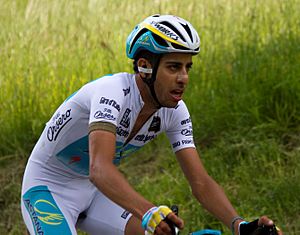
The young rider classification is for riders who are 25 years old or younger during the race year. The leader is determined the same way as the general classification: the eligible young rider with the lowest total time. This classification was added in 1976. It was stopped for a while but brought back in 2007.
The leader of this classification wears a white jersey. Some riders have won both the young rider classification and the overall general classification in the same year, like Nairo Quintana in 2014 and Tao Geoghegan Hart in 2020.
Team Classifications
There are two team competitions: the Trofeo Fast Team and the Trofeo Super Team.
- The Trofeo Fast Team is the oldest, started in 1909. It's won by the team with the lowest total time, calculated by adding the times of their best three riders on each stage.
- The Trofeo Super Team was a points-based competition for teams, where the top 20 riders on each stage earned points for their team. This classification was stopped in 2017.
Other Awards
The Giro also has other smaller awards, like:
- The Traguardo Volante (TV) or Sprints classification, for points earned at intermediate sprints during stages.
- The Combativity classification, for riders who show the most fighting spirit by being in breakaways or attacking.
- The Azzurri d'Italia classification, based on points for finishing in the top three of each stage.
- The Trofeo Fuga Pinarello, for riders who spend the most kilometers in a breakaway.
Past Classifications
- The maglia nera (black jersey) was given to the rider who was last in the overall standings. It was used from 1946 to 1951. Riders sometimes tried to be last to wear this unique jersey!
- The intergiro classification was used from 1989 to 2005. Riders were timed at a specific point in the middle of each stage, and the leader wore a blue jersey.
The Race Stages
The Giro d'Italia usually has 21 or 20 stages, plus a short opening time trial called a prologue. There are also two or three rest days. The stages can be:
- Mass-start stages: Where all riders start together. Most stages are like this.
- Individual time trials: Riders race alone against the clock.
- Team time trials: Teams race together against the clock.
Italian sprinter Mario Cipollini holds the record for the most stage wins, with 42 victories.
The Giro d'Italia is famous for its very steep and difficult mountain climbs. Many stages feature tough climbs, especially in the Alps and Dolomites. Some of the most famous mountains in the Giro are the Passo dello Stelvio, Passo Pordoi, and the Passo di Gavia. Since 1965, the highest point in each Giro is called the Cima Coppi, named after the great Italian climber Fausto Coppi.
The first time trial in the Giro was in 1933. A time trial is sometimes the second-to-last or final stage. The first stage is often a short "prologue" to decide who wears the pink jersey on day one.
The first team time trial happened in 1937.
While the Giro mainly takes place in Italy, some stages start or finish in nearby countries. These include San Marino, France, Switzerland, Austria, Slovenia, and Vatican City. Other countries that have hosted parts of the Giro include Belgium, Denmark, Ireland, Germany, Greece, Israel, Netherlands, and the United Kingdom.
Start and Finish of the Giro

For many years, the Giro traditionally started and finished in Milan, where the Gazzetta dello Sport newspaper is based. However, since the 1960s, the starting city changes each year. The race also finishes in different cities like Verona, Brescia, Trieste, Turin, and Rome.
The start of the Giro d'Italia, called La Grande Partenza (The Big Start), is a very important event. Cities spend a lot of money to host it, hoping to attract tourists and gain attention.
Starts Outside Italy
For the first 47 races, the Giro always started in Italy. In 1965, the race had its first start outside Italy, in San Marino. Since then, it has started outside Italy many more times. For example, the 2018 race started in Jerusalem. The planned start of the 2020 race in Hungary was cancelled due to the COVID-19 pandemic.
| Year | Country | City | Ref(s). |
|---|---|---|---|
| 1965 | City of San Marino | ||
| 1966 | Monte Carlo | ||
| 1973 | Verviers | ||
| 1974 | Vatican City | ||
| 1996 | Athens | ||
| 1998 | Nice | ||
| 2002 | Groningen | ||
| 2006 | Seraing | ||
| 2010 | Amsterdam | ||
| 2012 | Herning | ||
| 2014 | Belfast | ||
| 2016 | Apeldoorn | ||
| 2018 | Jerusalem | ||
| 2022 | Budapest | ||
| 2025 | Durrës |
Watching the Giro
The Giro is shown on TV and online all over Europe and in other parts of the world. Some places where you can watch it include:
- Europe: Eurosport
- Italy: Rai Sport
- France: L'Équipe TV
- United States: HBO Max
Related Cycling Events
- Giro d'Italia Women: There's also a women's version of the Giro, which has been held since 1988. It's one of the longest races in women's professional cycling.
- Giro Next Gen: An under-23 version of the Giro started in 1970. This race is also organized by the same company that runs the men's Giro.
See also
 In Spanish: Giro de Italia para niños
In Spanish: Giro de Italia para niños
- List of Giro d'Italia general classification winners


